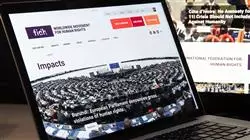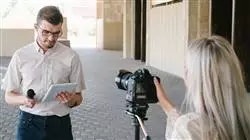University certificate
The world's largest faculty of journalism and communication”
Introduction to the Program
Become an excellent journalist and learn how to tell what is happening in the world"

Journalism studies are one of the most demanded in all universities, since this profession has a great influence on the population and has gained great prominence since its beginnings. Journalism encompasses different branches: social, cultural, economic, sports, international, events, conflicts, etc. This makes it necessary for professionals in this field to specialize in order to tell stories in the most appropriate way in each case.
Additionally, the transmission of information can be carried out through different media. Specifically, this program aims to specialize students in Communication Theory. To do so, it is necessary to acquire a series of skills that allow you to put into practice all that has been learned.
The syllabus addresses all aspects related to social communication, from methods and communicative behavior to communication in groups and masses, or the form of telepresence communication, among other aspects.
This program is the most complete and directed so that the professional in the field of Journalism and communication reach a higher level of performance, based on the fundamentals and latest trends in the media. Take advantage of the opportunity and become a professional with solid foundations through this academic program and the latest educational technology 100% online.
This program will allow you to improve your skills and become a successful Journalist”
This Postgraduate certificate in Communication Theory contains the most complete and up-to-date program on the market. The most important features include:
- The development of case studies presented by experts in Communication Theory
- The graphic, schematic, and practical contents with which they are created provide scientific and practical information on the disciplines that are essential for professional practice
- Practical exercises where the self-assessment process can be carried out to improve learning
- Special emphasis on innovative methodologies for teaching Communication Theory
- Algorithm-based interactive learning system for decision-making in the situations that are presented to the student
- Theoretical lessons, questions to the expert, debate forums on controversial topics, and individual reflection assignments
- Content that is accessible from any fixed or portable device with an Internet connection
This Postgraduate certificate is the perfect way to complement your knowledge in Journalism and Communication"
Its teaching staff includes professionals from the world of journalism, who bring to this program the experience of their work, as well as renowned specialists from prestigious reference societies and universities.
Its multimedia content, developed with the latest educational technology, will enable the professional to contextual and situated learning, i.e., a simulated environment that will provide immersive learning programmed to be prepared for real situations.
This program is designed around Problem-Based Learning, whereby the professional must try to solve the different professional practice situations that arise throughout the program. To do so, the professional will be assisted by an innovative interactive video system created by renowned and experienced experts in the field of Theory of Communication.
Don't miss the opportunity to increase your skills in Communication Theory"

Join our community of students and acquire the most advanced knowledge in your career"
Syllabus
The structure of the contents has been designed by a team of professionals in Audiovisual Screenwriting for audiovisual media, who are aware of the importance of up-to-date professional development in order to be able to deepen the area of knowledge, through the use of the available tools.

We have the most complete and up-to-date program on the market. We strive for excellence and for you to achieve it too"
Module 1. Social Communication Theory
1.1. The Art of Communicating
1.1.1. Introduction: The Study of Communication as a Social Science
1.1.2. Knowledge
1.1.2.1. Sources of Knowledge
1.1.3. The Scientific Method
1.1.3.1. The Deductive Method
1.1.3.2. Inductive Method
1.1.3.3. Hypothetico-Deductive Method
1.1.4. Common Concepts in Scientific Research
1.1.4.1. Dependent and Independent Variables
1.1.4.2. Hypotheses
1.1.4.3. Operationalization
1.1.4.4. The Law or Theory of Hedging
1.2. Elements of Communication
1.2.1. Introduction
1.2.2. Elements of Communication
1.2.3. Empirical Research
1.2.3.1. Basic Research vs. Applied Research
1.2.3.2. Research Paradigms
1.2.3.3. Values in Research
1.2.3.4. The Unit of Analysis
1.2.3.5. Cross-Sectional and Longitudinal Studies
1.2.4. Define Communication
1.3. Trends in Social Communication Research
1.3.1. Introduction. Communication in the Ancient World
1.3.2. Communication Theorists
1.3.2.1. Greece:
1.3.2.2. The Sophists, Early Communication Theorists
1.3.2.3. Aristotelian Rhetoric
1.3.2.4. Cicero and the Canons of Rhetoric
1.3.2.5. Quintilian: The Oratorical Institution
1.3.3. The Modern Period: The Theory of Argumentation
1.3.3.1. Anti-Rhetoric Humanism
1.3.3.2. Communication in Baroque
1.3.3.3. From the Enlightenment to Mass Society
1.3.4. The 20th Century: The Rhetoric of the Mass Media
1.3.4.1. Media Communication
1.4. Communicative Behavior
1.4.1. Introduction: The Communicative Process
1.4.2. Communicative Behavior
1.4.2.1. Animal Ethology and the Study of Human Communication
1.4.2.2. The Biological Background of Communication
1.4.2.3. Intrapersonal Communication
1.4.2.4. Patterns of Communicative Behavior
1.4.3. The Study of Non-Verbal Communicative Behavior
1.4.3.1. The Movement of the Body as a Pattern of Communicative Action
1.4.3.2. The Latent Content of Non-Verbal Communication: Deception in Body Movements
1.5. The Communicative Transaction
1.5.1. Introduction: The Communicative Transaction
1.5.2. Transactional Analysis
1.5.2.1. The I-Child
1.5.2.2. The Father-Self
1.5.2.3. The Adult-Self
1.5.3. Classification of Transactions
1.6. Identity, Self-Concept and Communication
1.6.1. Introduction
1.6.2. Identity, Self-Concept and Communication
1.6.2.1. Transactional Micropolitics and Self-Concept: Interaction as Negotiation of Identities
1.6.2.2. The Strategy of Negative Emotions
1.6.2.3. The Strategy of Positive Emotions
1.6.2.4. The Strategy to Induce Emotions in Others
1.6.2.5. The Mutual Commitment Strategy
1.6.2.6. The Strategy of Pity or Understanding
1.6.3. The Presentation of Oneself in Everyday Rituals
1.6.3.1. Symbolic Interactionism
1.6.4. Constructivism
1.6.5. Self-Concept Motivated to Interact
1.6.5.1. The Theory of Reasoned Action
1.6.6. Conversational Pragmatics
1.7. Communication in Groups and Organizations
1.7.1. Introduction: The Communicative Process
1.7.2. Communicative Behavior
1.7.2.1. Animal Ethology and the Study of Human Communication
1.7.2.2. The Biological Background of Communication
1.7.2.3. Intrapersonal Communication
1.7.2.4. Patterns of Communicative Behavior
1.7.3. The Study of Non-Verbal Communicative Behavior
1.7.3.1. The Movement of the Body as a Pattern of Communicative Action
1.7.3.2. The Latent Content of Non-Verbal Communication: Deception in Body Movements
1.8. Media Communication I
1.8.1. Introduction
1.8.2. Media Communication
1.8.3. Characteristics of the Media and its Messages
1.8.3.1. The Mass Media
1.8.3.2. Media Functions
1.8.4. The Powerful Effects of the Mass Media
1.8.4.1. The Media Tells us What to Think and What not to Think
1.9. Media Communication II
1.9.1. Introduction
1.9.2. The Hypodermic Theory
1.9.3. The Limited Effects of the Media
1.9.4. The Uses and Gratifications of Mass Communications
1.9.4.1. Theory of Uses and Gratifications
1.9.4.2. Origins and Principles
1.9.4.3. Objectives of the Theory of Uses and Gratifications
1.9.4.4. Expectations Theory
1.10. Media Communication II
1.10.1. Introduction
1.10.2. Computerized Communication and Virtual Reality
1.10.2.1. Computer-mediated Communication: The Problem of its Theoretical Integration
1.10.2.2. Definitions of Computerized Communication
1.10.3. Evolution of the Theory of Uses and Gratifications
1.10.3.1. Reinforcements of Media Dependency Theory
1.10.4. Virtual Reality as an Emerging Object of Study
1.10.4.1. Psychological Immersion of the User
1.10.5. Telepresence

A unique, key, and decisive educational experience to boost your professional development”
Postgraduate Certificate in Communication Theory
In today's world, communication has become an indispensable tool for interaction between individuals and organizations. Globalization and technological development have made communication a priority need in modern society. For this reason, at TECH Global University we have designed the Postgraduate Certificate in Communication Theory, to educate professionals capable of understanding communication processes in different contexts and develop skills to apply them in practice.
This course will address the fundamental concepts of communication theory, the importance of communication in society, the analysis of the media and its impact on today's society, as well as the relationship between communication and technology. Students will have the opportunity to learn the different communication techniques and how to apply them in everyday situations and in the work environment. In addition, the course will also include the analysis of the different types of communication and how to apply them in practice.







